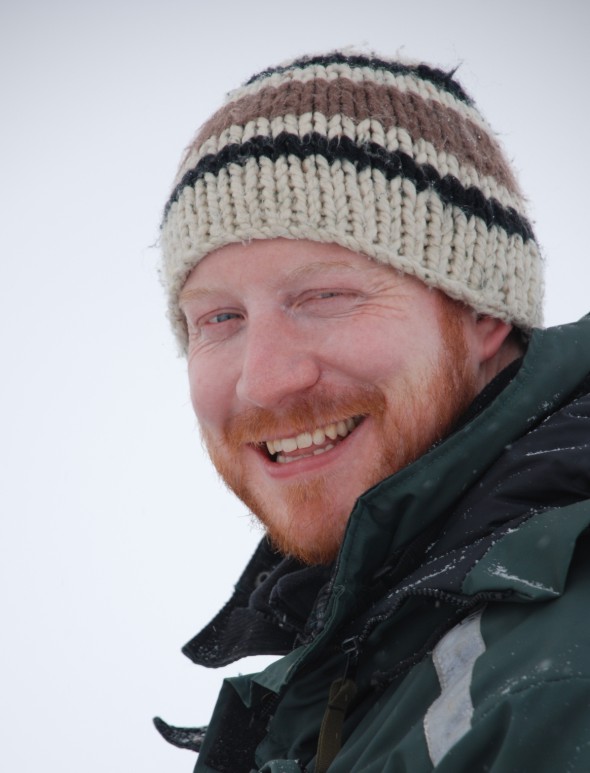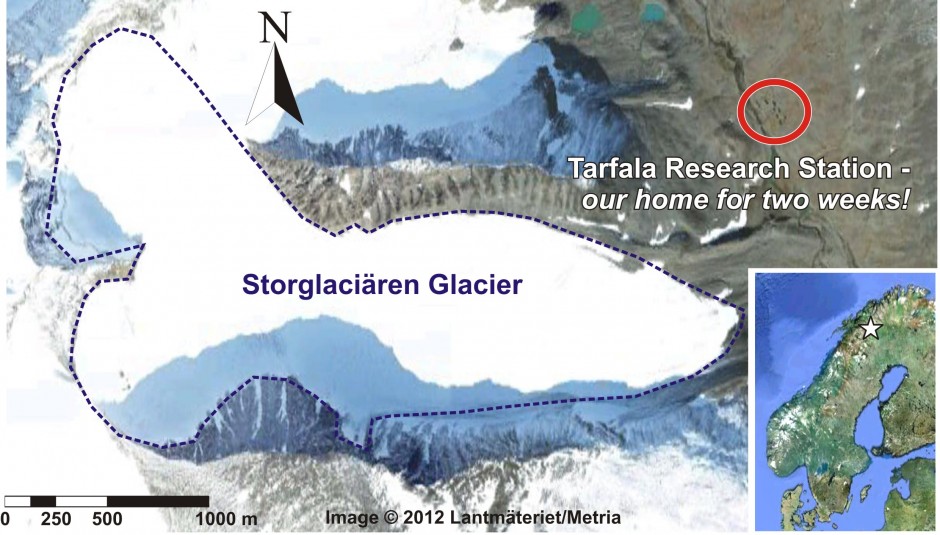As the Arctic wakes up from its polar night, Dr Adam Booth is leading a team of UK geophysicists on a two-week campaign of seismic investigations on Storglaciären, a mountain glacier in northern Sweden. He will be reporting on the expedition in a series of posts published here in GeoLog.
Hi, and thanks for your interest in our field trip! For the next two weeks, my colleagues and I will be sending back reports from our campaign on Storglaciären – today’s post introduces the project and, of course, the team.
I’m writing this from my office at Swansea University, ahead of our trip to northern Sweden. My name is Adam Booth, I’m a post-doc in Swansea’s Glaciology Group, funded by the Climate Change Consortium of Wales, C3W, project, and I specialise in the application of geophysical methods (specifically seismic and radar) to glaciological problems. I use geophysics both to measure the thickness of a glacier, but also to quantify various physical properties of the ice and the material it sits on. For example, the speed of seismic energy can tell me how much liquid water a glacier contains [1], whereas the strength of a seismic reflection tells me a great deal about the material beneath the glacier bed [2]. It is this latter method that we will apply at Storglaciären, and we hope to introduce a new dimension to glaciological interpretation of seismic datasets.
Storglaciären is 3.2 km long, has a maximum thickness of 230 m, and sits some 150 km north of the Arctic Circle in the shadow of Kebnekaise, Sweden’s highest mountain at 2104 m. Such ‘mountain glaciers’ are important to understand for climate change purposes, since their melt currently contributes more to global sea-level rise than the larger Greenland and Antarctic ice sheets [3]. For our group, however, Storglaciären also represents an ideal ‘natural laboratory’ where we can test new geophysical ideas. Although we’d certainly aim to apply our methods on Antarctica, it is far easier and cheaper to develop new techniques at Storglaciären – particularly because of the logistical support offered by the Tarfala Research Station, which is within snowshoed walking distance of the glacier front.
Four of us are making this journey north. Joining me from Swansea University are Prof. Tavi Murray and PhD student Charlotte Axtell, and we also bring along Dr. Roger Clark from the Institute of Geophysics and Tectonics at the University of Leeds.
Tavi is Swansea’s Chair of Glaciology and, as such, has enormous glaciological expertise and is an accomplished geophysicist in her own right; she has completed field campaigns on too many glaciers to list, and has close links with the British Antarctic Survey. Charlotte, by the end of her PhD, will know Storglaciären inside-out, as her project focuses on seismic and radar methods to investigate the glacier’s liquid-water content. At the moment, she is attending a glaciology training course on Svalbard, from where she informs me that, “it is amazing, and if I could, I’d just stay here!” Finally, Roger has near-encyclopedic knowledge of the cutting-edge seismic methods that are developed and used in the hydrocarbons industry. In recent years, he has been instrumental in helping us open that toolbox for glaciological applications.
I should also acknowledge support from the INTERACT scheme, who funds this fieldwork. This is a truly fantastic initiative, which provides logistical support and access to Arctic research stations. And it’s not only for glaciologists! INTERACT’s website currently highlights diverse research themes, including for studying biodiversity, palaeo-climatology and geochemistry.
Aerial view of Storglaciären (from Google Earth). The Kebnekaise mountain is immediately west of the glacier, and Tarfala Research Station is the small collection of huts in the red circle. Inset: our location in Sweden
We leave for Sweden on 23 March, and we hope to be in Tarfala two days later. I’m hoping for a smooth journey – but also that the recent high-activity Northern Lights are still active by the time we arrive. Watch this space for updates, and the latest on our project’s progress!
Further reading:
[1] Endres AL, Murray T, Booth AD and West LJ (2009): A new framework for estimating englacial water content and pore geometry using combined radar and seismic wave velocities. Geophysical Research Letters, 36, L04501.
[2] Booth AD, Clark RA, Kulessa B, Murray T and Hubbard A (2012): Thin-layer effects in glaciological seismic AVA analysis: implications for characterising a subglacial till unit, Russell Glacier, West Greenland. The Cryosphere Discuss, 6, 759-792
[3] Intergovernmental Panel on Climate Change (IPCC) (2007): IPCC 4th Assessment Report: Climate Change 2007 (AR4).By Adam Booth, post-doc at Swansea University
Check out the second post in the series here!




Dave Anderson
That is really cool that someone is able to use geophysics to measure the thickness of a glacier and quantify various physical properties of the ice and material it sits on. That sounds really interesting and I would love to look more into it. Geophysics has always been something that interests me.